Lion850
National Hazard
   
Posts: 517
Registered: 7-10-2019
Location: Australia
Member Is Offline
Mood: Great
|
|
Lead + Iodine in HCl
This is a continuation of my experiments to see how iodine reacts with metals in the presence of concentrated hydrochloric acid.
- 6.2g lead powder and 6g iodine crystals were placed an evaporating dish and 13ml concentrated HCL added.
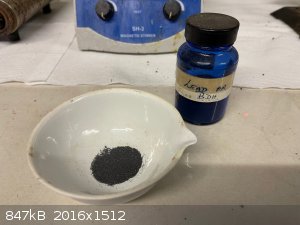 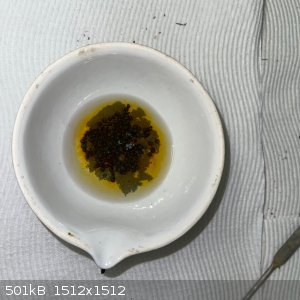
- After a few days some yellow bits started to appear seeming to indicate lead iodide was being formed. It was a slow process, and only after 20 days
had all the iodine color appeared from the solution; and it was clear.
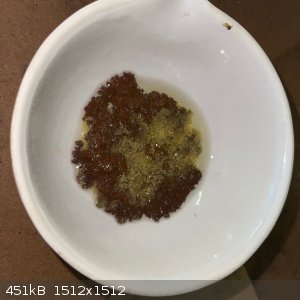
- The contents was filtered, and washed with some 50ml water in the funnel. - The filtrate was clear with a very slight yellow tinge. When the
filtrate was tested with some potassium iodide solution, a yellow participate of lead iodide was observed but only a minuscule amount; this was
filtered off and dried and measured at less than 0.2g.
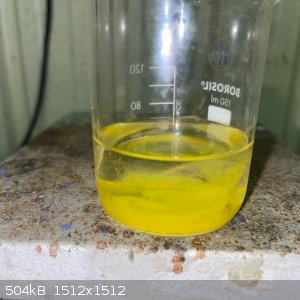
- The remainder was a mix of brown and yellow material.
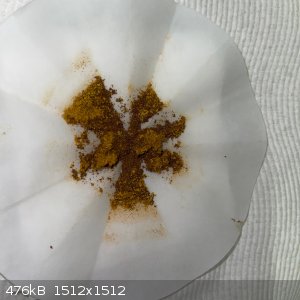
- Assuming the yellow material to be lead iodide, I decided to try to extract the iodide with boiling water, being that PbI2 is somewhat soluble at
water near 100C.
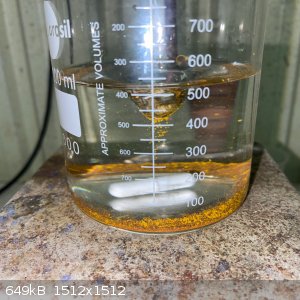
- The remainder was added to a beaker with 500ml water, brought to near boil and stirred for 10 minutes.
- Once stirring stopped the brown material settles very quick (seems quite dense) and the still near boiling supernatant liquid was decanted through a
filter.
- This was repeated once more. By this point, visually, it seemed most of the yellow material had disappeared with predominantly brown material left.
- The hot filtrate was completely clear solution, but the lovely spectacle of golden rain soon appeared as it cooled.
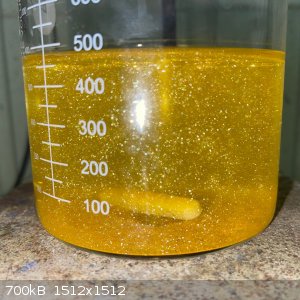
- The next day when the filtrate was cold and all golden flakes settled the contents was filtered to extract all solid lead iodide. The filtrate of
this process was then steamed down from 900 to some 80ml, by which time a lot of lead iodide was crystalizing even at boiling point. The beaker was
again left to cool overnight and then filtered, and the crystals left to dry on the bench for a few days. I managed to pull a film of dry lead iodide
off the one filter paper; looks very nice.
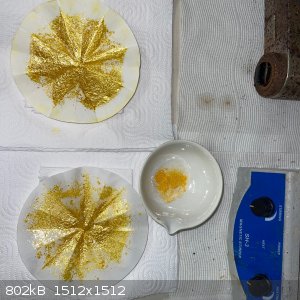 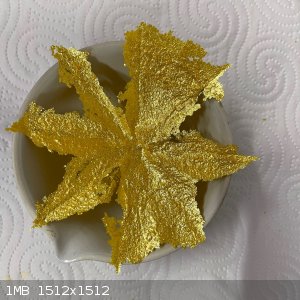
- Final yield was 3.1g of lead iodide and 6.1g of the brown material.
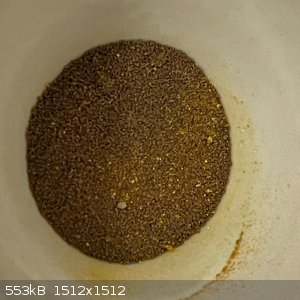
What is this brown material?
Making 3.1g PbI2 would consume 1.4g of lead and 1.7g of iodine. That leaves 4.8g of lead and 4.3g iodine "unaccounted"; however for sure there was
some mechanical losses, but I would think not more than 20%.
I wonder if this reaction was also happening:
Pb+I+HCl=PbICl + HI
Lead (ii) iodo chloride is mentioned online but very little detail; I cannot find a description, and I have no idea how readily it forms.
Will have to think of tests to do on the brown product to see what it contains Suggestions welcomed 
|
|
|
Bezaleel
Hazard to Others
  
Posts: 444
Registered: 28-2-2009
Member Is Offline
Mood: transitional
|
|
Hi, my guess is that the lead had only partly dissolved and that the lead particles had become covered with PbI2, PbCl2 and maybe PbO, which acted as
an inert layer.
Since PbCl2 is somewhat soluble in water, adding KI to your filtrate produced PbI2.
After boiling the lead which had remained, the majority of the inert layer dissolved. Both PbI2 and PbCl2 are much better soluble in hot water than in
cold water. I guess that what remains of the coating is mainly a mix of PbI2 and PbO. That would explain the brown colour of the solid.
If you try to solve the heavy particles in nitric acid, you can test for Pb. Weigh the dried particles first. Add some sulphate to the solution in
nitric acid and filter off the PbSO4 and rinse. By weighing the unused filter paper and the dried filter containing the PbSO4, you can estimate the Pb
content.
I have used such procedures oftentimes and usually the accuracy is within 10% of expected results.
The missing iodide was maybe present in the form of polyiodides and went into your filtrate. It would have been interesting to see what neutralising
your solution with a mild base would have done.
|
|
|
Lion850
National Hazard
   
Posts: 517
Registered: 7-10-2019
Location: Australia
Member Is Offline
Mood: Great
|
|
Hi Bezaleel I'll do the Pb test as you suggested. Thanks.
|
|
|
Fantasma4500
International Hazard
    
Posts: 1681
Registered: 12-12-2012
Location: Dysrope (aka europe)
Member Is Offline
Mood: dangerously practical
|
|
you could try redoing it so you have some more material to play around with
then you could try subjecting the brown material to various acids, bases
reacting it with nitric acid would explain if theres metal in it- this would give off NOx fumes
otherwise you may try to heat it up past melting point, i cant quite remember the whole but theres something about lead oxides changing structure upon
heating
PbO to Pb3O4 maybe? very nice photos
i would like to also add, if a solid in filter clumps together, this would imply that it wasnt throughly washed, or that the filtered material was to
some extent watersoluble
one trick is to rinse it with some acetone, this also significantly downs the drying time, and most inorganics are insoluble in acetone, so even
heating up the filtrate solid with acetone in it wont cause it to clump together as solubility may climb a bit due to heating
|
|
|
Bezaleel
Hazard to Others
  
Posts: 444
Registered: 28-2-2009
Member Is Offline
Mood: transitional
|
|
Quote: Originally posted by Antiswat  | otherwise you may try to heat it up past melting point, i cant quite remember the whole but theres something about lead oxides changing structure upon
heating
PbO to Pb3O4 maybe? very nice photos |
Yes, PbO2 looses oxygen in several stages, passing through Pb3O4 starting at around 375C, and ending in PbO at around 650C (Greenwood & Earnshaw,
Chemistry of the Elements, 2nd ed, p 386). (Is this what you are referring to, Antiswat?) However, personal experience shows that in crude heating
over a gas flame, the intense orange of the intermediate steps does not need to become apparent.
Besides, mind your glassware! When I heated PbO2 it was converted to PbO, which melted and cracked the boro beaker on cooling, despite the very small
amount used, see picture.
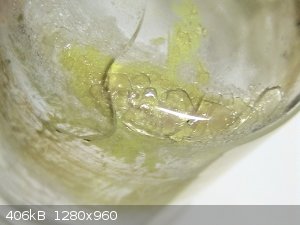
|
|
|
Lion850
National Hazard
   
Posts: 517
Registered: 7-10-2019
Location: Australia
Member Is Offline
Mood: Great
|
|
I tried to determine the lead content of the brown powder as suggested above.
- Dry filter paper = 1.5g.
- Put 2g of brown powder in a small beaker.
- Added 4g 70% HNO3. yellow-orange fumes with NOx smell was immediately seen, but these stopped quite quickly. This probably shows that there was some
free lead present.
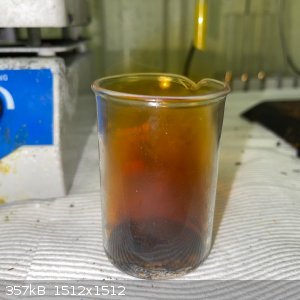
- After the fumes stopped, heat up the beaker slowly on a hot plate. Fumes started again, but much more red. I think this was a mix of iodine and
possible more NOx fumes. Intriguingly there was not the usual iodine smell, and actually not much smell at all, but maybe the fumes had deadened my
sense of smell by then!
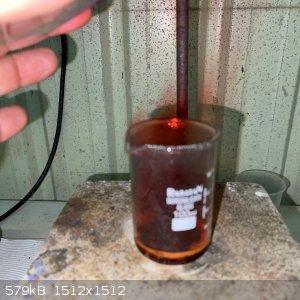
- The next day there was now a black ppt in the beaker that looked like iodine. I added 30ml water and boiled, purple iodine fumes was expelled. I
kept adding water to keep the level between 20 and 30ml until the solution was completely clear and there was no more fumes.
- 4g K2SO4 was dissolved in 30ml water (heated to get a clear solution) and then added to the beaker with the lead product. It immediately went cloudy
and a white ppt quickly settled.
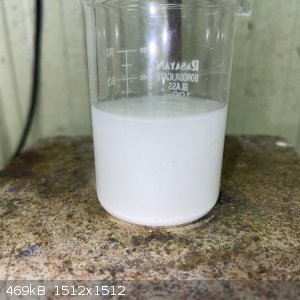
- The solution was filtered and the filter paper + presumably lead sulfate dried on the bench for 3 days, by which time the weight was stable at 3.4g,
indicating the PbSO4 was 3.4 - 1.5 = 1.9g.
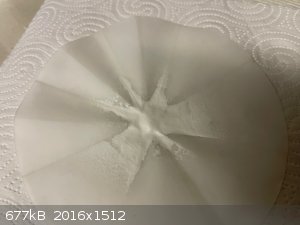
- Thus, 2g of brown powder contains roughly 1.298g lead. Or 65% by weight.
- The only other test I did was to put some powder on a piece of galvanized plate and heat it for 10 minutes on the hot plate max setting, which
should have been to around 250C at least. The powder when hot turns more red.
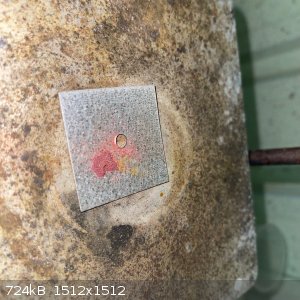
- Once cooled it is brown again, and still the same consistency.
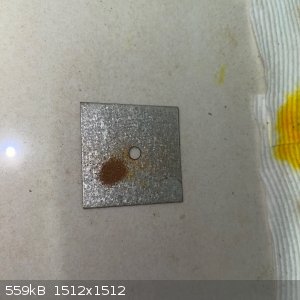
- But, then I looked again 2 days later it was black and seemed a bit wet with some bubbles! While the original powder is still unchanged. Was it the
heat, or a reaction with the zinc galvanizing?
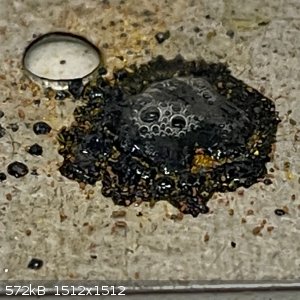 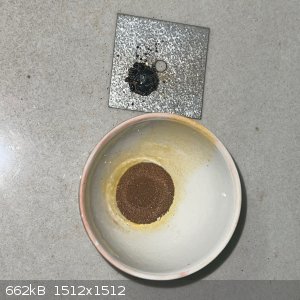
So what I know about the brown powder by now:
- Course heavy but free flowing powder (heavy as in settles quick in water after stirring stops).
- Not affected by boiling water
- Contains around 65% lead by weight
- Contains iodine
- Color changes to more red when heated to above 250C, but when cooled appears same as before, both color and consistency.
- Possible react if left in contact with zinc in air - needs more investigation.
Atomistry says: "The basic chloriodide PbI2.PbCl2.PbO, which has been prepared artificially, occurs as the mineral schwarzenbergite."
According to my stoichiometry app 2g of this basic lead chloriodide should contain 1.292g of lead. This fits nicely 
I think the next step should be to determine if it contains chlorine.
[Edited on 3-5-2022 by Lion850]
|
|
|
Lion850
National Hazard
   
Posts: 517
Registered: 7-10-2019
Location: Australia
Member Is Offline
Mood: Great
|
|
Following on from my post above.
Yesterday I took a tiny bit of the original brown powder from the crucible and placed it on a galvanized plate. And this morning it is black and
appears sticky with tiny bubbles, similar to the photo above. So the brown powder reacts this way with galvanized plate irrespective of whether it was
heated or not.
|
|
|
reactofurnace
Hazard to Self
 
Posts: 76
Registered: 17-7-2015
Member Is Offline
Mood: Volatile
|
|
I would have to agree with the previous replies. It seemed to be lead oxide. Or it can be the unreacted lead that might have been stained.
I think the reaction is likely:
Pb + 2HCl ---> PbCl2 + H2
This reaction is likely very slow due to low solubility.
Then a single replacement rxn with I2 :
PbCl2 + I2 ---> PbI2 + Cl2
|
|
|